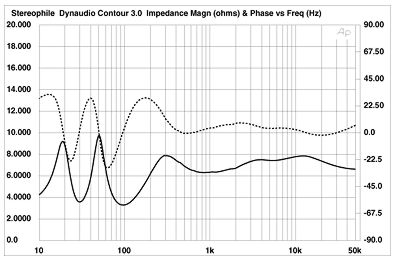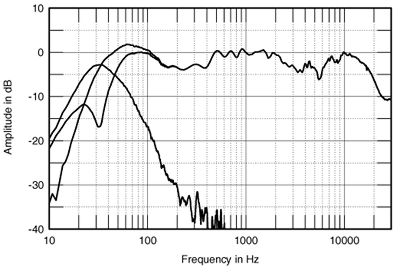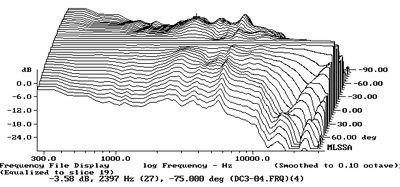| Columns Retired Columns & Blogs |
Dynaudio Contour 3.0 loudspeaker Measurements
Sidebar 3: Measurements
Footnote 1: When I analyzed the data I had collected on the more than 350 loudspeakers I had measured up to June 1997 to prepare a paper for the Audio Engineering Society ("Loudspeakers: What Measurements Can Tell Us—And What They Can't Tell Us," AES Preprint 4608, presented at the 103rd AES Convention, New York, September 1997 and reprinted in somewhat different form as as "Measuring Loudspeakers" in Stereophile), the mean B-weighted sensitivity was 88dB(B)/2.83V/m, with a median value of 85dB(B).—JA
The Dynaudio Contour 3.0's voltage sensitivity was to specification at 86dB(B)/2.83V/m; as LG notes, this is below average for a dynamic speaker (footnote 1). However, it draws quite a lot of current from the partnering amplifier to achieve this sensitivity, as can be seen from its plot of impedance magnitude and phase against frequency (fig.1), measured with an Audio Precision System One. The impedance reaches a minimum value of 3.5 ohms at 100Hz and remains below 8 ohms over almost the entire audio band. The saddle between the twin peaks in the bass in this graph indicates that the 2"-diameter reflex port is tuned to a low 32Hz.

Fig.1 Dynaudio Contour 3.0, electrical impedance (solid) and phase (dashed) (2 ohms/vertical div.).
As Larry didn't audition the speakers with the foam plug in the port—Wes Phillips found the Contour 3.3 to sound too lean this way—I measured the speaker with the port unblocked, using DRA Labs MLSSA system and a Mitey Mike II microphone. The result can be seen on the left of fig.2: the port's output is the well-defined bandpass centered on its tuning frequency of 32Hz, and is free from organ-pipe resonances; and the woofer output starts to roll off an octave higher, while the complex sum of the woofer and port outputs (top trace) peaks a little in the midbass. There is somewhat of a depression in the lower midrange; partly this will be due to the nearfield technique I use to make these low-frequency measurements, but it also showed up in some farfield responses.

Fig.2 Dynaudio Contour 3.0, anechoic response on tweeter axis at 50", averaged across 30 degrees horizontal window and corrected for microphone response, with complex sum of the nearfield midrange, woofer, and port responses plotted below 300Hz.
Higher in frequency (and measured using a calibrated B&K 4006 microphone), the Dynaudio has a slight but broad peak in the upper midrange. Depending on the music, this might also be perceived as slight lacks of energy in the lower midrange and presence region. However, as can be seen from the graph showing the speaker's lateral dispersion (fig.3), the off-axis behavior goes a long way toward compensating for the on-axis aberrations. In a typical room, the balance throughout the midrange and mid-treble might well be perceived as flat. However, the soft-dome tweeter does have limited dispersion in its top octave; as the on-axis response isn't exaggerated in this region to compensate, the speaker might sound too mellow in overdamped or very large rooms.

Fig.3 Dynaudio Contour 3.0, horizontal response family at 50", normalized to response on tweeter axis, from back to front: differences in response 90 degrees-5 degrees off-axis; reference response; differences in response 5 degrees-90 degrees off-axis.
Footnote 1: When I analyzed the data I had collected on the more than 350 loudspeakers I had measured up to June 1997 to prepare a paper for the Audio Engineering Society ("Loudspeakers: What Measurements Can Tell Us—And What They Can't Tell Us," AES Preprint 4608, presented at the 103rd AES Convention, New York, September 1997 and reprinted in somewhat different form as as "Measuring Loudspeakers" in Stereophile), the mean B-weighted sensitivity was 88dB(B)/2.83V/m, with a median value of 85dB(B).—JA
- Log in or register to post comments




































